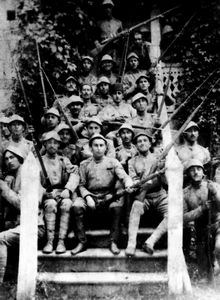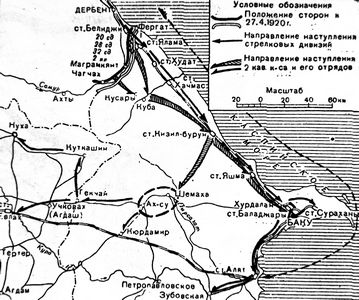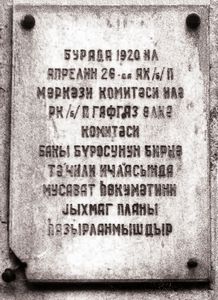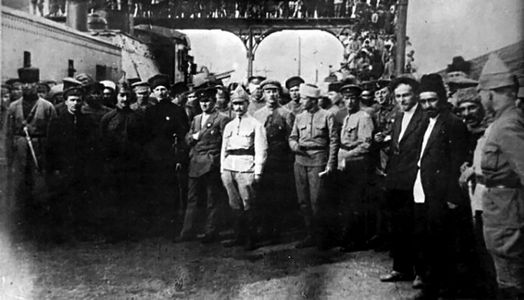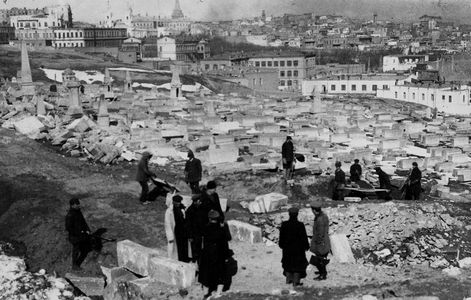Struggle for independence of Azerbaijan
Armenian chauvinists, who received heavy blows in the events of 1905-1906, did not announce their claims to Azerbaijani lands at some point. However, the situation sharply deteriorated in 1917. Armenian armed formations created as part of the Russian army to fight Turkey began to withdraw from the territory of Anatolia in 1917, and some of them were posted on Azerbaijani lands. These forces attacked Azerbaijani villages and killed people. In May 1918, the state of Armenia, which was proclaimed on the ancestral lands of Azerbaijan, announced territorial claims to all neighbours - Azerbaijan, Turkey and Georgia. Backed by its patrons in Europe, the US and Russia, Armenia sought to carry out its plans. At the same time, the aforesaid powers used Armenia as a means of pressure on the countries of the region and to create chaos and a military, political and economic crisis here.
Using the fact that in May-September 1918, the Azerbaijan Republic was forced to wage a war on the Baku front, the Armenians began to expel the Azerbaijani population from Iravan and surrounding areas. Later the ethnic cleansing spread to Zangazur and Karabakh. In the Iravan province, as a result of the massacre of Azerbaijanis, more than 70,000 refugees went to South Azerbaijan, and there were another 400,000 refugees in Nakhchivan and surrounding lands. More than 45,000 refugees died because of wounds, diseases and hunger. To prevent a massacre, the 1st Azerbaijani Infantry Division and Turkish units that supported it launched a campaign in Karabakh in September-October 1918. Armenian armed forces who received direct military support from Armenia were defeated here. On 4 October, a parade of Azerbaijani-Turkish units was conducted in Shusha, and after that, the situation in the region stabilized.
However, under the Treaty of Mudros, Turkey as the losing party withdrew its troops from Azerbaijan, and the situation deteriorated again.
Destroying Azerbaijani villages and killing Azerbaijanis, Armenians falsified facts, presented themselves as victims and conducted anti-Azerbaijani propaganda worldwide. Taking advantage of patronage by the Entente countries, Armenia resumed its expansionist policies. Uniting all Armenian troops under his command, Andranik attacked Zangazur, Nakhchivan and Karabakh, and rebuffed by Azerbaijan units, he immediately took refuge in Armenia. At a time when diplomatic notes addressed to Armenia, as well as appeals to representatives of the Entente in the Caucasus had no effect, the government of Azerbaijan in January 1919 established the Karabakh Governorate General, which included the lands of the Shusha, Javanshir, Jabrayil and Zangazur counties. Khosrov Pasha Sultanov was appointed governor-general. Taking decisive measures, Sultanov defeated Armenian troops and got emissaries from Armenia expelled to Tbilisi. However, the Armenians continued the genocide of Azerbaijanis in Zangazur. According to the conclusion of the Extraordinary Commission of Inquiry, 115 Muslim villages were destroyed in the Zangazur county.
In these villages, 3,257 men, 2,776 women and 2,196 children were killed, and 1,060 men, 794 women and 485 children were wounded. In order to prevent the genocide of Azerbaijanis committed by Armenian Dashnak gangs, the government of Azerbaijan carried out a military operation in Zangazur on 3-7 November 1919. However, the Zangazur expedition was not completed. As the governments of Azerbaijan and Armenia resolved the Zangazur issue through negotiations, the fighting was stopped. On 23 November, the Prime Minister of the Azerbaijan Republic Nasib Yusifbayli and Prime Minister of the Republic of Armenia Khatisov signed an agreement in Tbilisi with the mediation of the Deputy High Commissioner of the Entente in the South Caucasus J. Ray. But the government of Armenia violated the agreement and sent troops to Zangazur on 8 December. However, the Entente pretended that they did not notice the violation of the agreement.
On 22 March 1920, the Armenian forces launched a simultaneous attack on Shusha, Khankandi, Asgaran, Khojali and Tartar. An offensive also began on the western borders of Azerbaijan. The Azerbaijani army mobilized its forces, repelled the offensive on the western borders and defeated the Armenian forces that had attacked Karabakh. By 3 April, the situation was restored. Such developments in Karabakh played an important role in the preparation of Soviet Russia and Bolsheviks in the country for aggression against Azerbaijan, as the main forces of the Azerbaijani army were concentrated on the western borders.
The Araz-Turkic Republic (APR). Due to the policy of "scorched earth-ethnic cleansing" carried out by Armenia in 1918-1920, Nakhchivan was faced with a large number of refugees. The attacks of Armenian troops on Nakhchivan led to the death of large numbers of civilians. In total, 73,727 people of the Turkic-Muslim population were killed in Nakhchivan in 1918-1921.
The Araz-Turkic Republic, which existed from November 1918 to March 1919, covered Nakhchivan, Sharur-Daralazi and Ordubad mahals and the land of Sardarabad, Ulukhanli, Vedibasar, Gamarli, Mehri, and others. The republic with its centre in Nakhchivan had established governance bodies. Its parliament consisted of members of Muslim national councils of the region. The government was headed by Amir Akbarzadeh. The establishment and short-term activities of the ATR were of great importance.
The republic played a major role in mobilizing the region's forces to repel the Armenian aggression. Preventing the seizure of territories by Armenian Dashnaks, the republic ensured the territorial integrity of Azerbaijan. In accordance with the resolute demand of the local population, the Nakhchivan Governorate General was established by the 28 February 1919 decision of the government of the Azerbaijan Republic. Bahram Khan Nakhchivanski was appointed governor-general, Karim Khan Iravanski his deputy for military affairs and Haji Mehdi Bagirov for civil affairs. Owing to the activities of the Nakhchivan Governorate General and the heroism of the local population, the Armenian aggression was averted.
April occupation and abolition of Azerbaijan Republic
It remains to be seen that strategic goal of the policy makers of the Soviet Russia was to seize Azerbaijan’s natural resources wealth, and first of all, to control over Baku oil; therefore, the Soviet Russia refused to recognize Azerbaijan’s independence.
Thus, on the preliminary plan, communists in Azerbaijan who had to accomplish a revolution and overthrow the government, as a full-fledged military ally were due to involve the army of the Soviet Russia.
On February 11-12, 1920 was held the Assembly of Baku Committee of the Russian Communist Party, of the organizations “Gummat” and “Adaliat.” Thereupon, a decision had been made to bring together all Communist organizations under the name of “Azerbaijan Communist Party of (Bolsheviks)”.
The first Assembly of the Azerbaijan Communist Party was aiming at forced overthrow of the Government of Azerbaijan Republic. That was already clear that uprising would not succeed. I.V. Stalin wrote: “This revolt had no chance to succeed. I therefore, believe we must inevitably to cross the border of Azerbaijan.” In this circumstances, the absence of military aid from Entente to countries of the South Caucasus; failure in attempting to consolidate military forces of Azerbaijan and Georgia in the face of Russian invasion; outside interference caused revolts instigated by Armenians; policy of Turkey leading struggle for independence, and establishing closer links with Soviet Russia; absence of internal stability in Azerbaijan which put the republic in danger, and face to face with external aggression.
On the night 26 – 27, April without any uprising, on behalf of Azerbaijan Transitional Revolutionary Committee was sent a radio telegram to Moscow, in order to request assistance and support: “As a result of coup that took place in Baku, we are seeking help and ask you to dispatch troops of the Red army in Baku”. So, the 11th Red Army with 70, 000 soldiers which was placed along the northern border immediately crossed the border of Azerbaijan and marched to Baku. In the battles along the borders not numerous Azerbaijan troops were defeated. Meanwhile, the basic forces of Azerbaijan army fought against aggression of Armenian in Karabakh. So, military incursion of the 11th Red army and a breach of international norms that further shaped future of Azerbaijan Republic.
At a time when the military forces of foreign state had been located in the territory of republic, under the direct military pressure, on April 27 the Parliament of Azerbaijan began to discussion ultimatum that had been presented to communists, so after the lively debates, by the 11 hour was made a decision to hand over power to Azerbaijan Revolutionary Committee under the following conditions (they were published on May 6, 1920 in the newspaper “Communist”):
1. Complete independence of Azerbaijan is guaranteed and will be governed by the soviet authority;
2. Government established by Azerbaijan Communist Party will be temporary executive authority;
3. Final form of governance in Azerbaijan will be determined by their own supreme legislative body represented by Soviet of Workers’, Peasants’ and Soldiers’ Deputies which had been elected without any external interference;
4. All government officials were remained in their posts, apart from those who had occupied senior executive posts;
5. New Temporary Communist Government guaranteed to ensure efficient protection of life and property of parliament and government officials.
6. In order to prevent incursion of the Red army units in Baku, will be taken all measures;
7. Irrespective of the fact, where the threat to the independence is coming from, new government is committed to prevent this risk, in accordance with the feasible means available to it.
However, when the Bolsheviks had come into the power, they convened all these conditions. Thus, on April 27, 1920 took place in violation a breach of international legal norms, as the Soviet army had occupied the territory of Azerbaijan Republic; independent Azerbaijan state was abolished.

